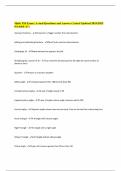,Introduction: How to Study Psychology
MULTIPLE CHOICE
1. According to your textbook authors, students who get good grades and remember more of the
material long after the course is over
a. studied early in the morning rather than right before they went to sleep.
b. worked smarter, not just longer and harder.
c. tended to read every chapter at least three times.
d. tried not to overlearn the material, since this usually causes confusion.
ANS: B DIF: Moderate REF: Introduction KEY: *
MSC: TYPE: Fact
2. According to Donald Norman, when we more or less passively let an event happen to us, we are
exhibiting __________ cognition.
a. reactive
b. reflective
c. contextual
d. experiential
ANS: D DIF: Moderate REF: Introduction MSC: TYPE: Fact
3. Experiential cognition involves
a. passively letting an event happen to you.
b. one’s subsequent memories being more detailed.
c. mindfully focusing on events.
d. going beyond the information given.
ANS: A DIF: Moderate REF: Introduction KEY: *, www
MSC: TYPE: Fact
4. Last night you vegged out in front of the TV set and watched a couple of hours of programs.
However, this morning you have trouble remembering the plot of any of the programs. According to
Donald Norman, your passive viewing of the television is a good example of
a. reflective cognition.
b. experiential cognition.
c. transient narcosis.
d. depersonalization.
ANS: B DIF: Moderate REF: Introduction MSC: TYPE: Application
5. You are flipping through the television channels when you come upon a program about your future
career. The next day you tell your best friend about all the details you learned from this program.
According to Donald Norman, when you were viewing the television program on your future
occupation, you were exhibited __________cognition.
a. reactive
b. reflective
c. experiential
d. contextual
ANS: B DIF: Moderate REF: Introduction MSC: TYPE: Application
© 2012 Cengage Learning. All Rights Reserved. This edition is intended for use outside of the U.S. only, with content that may be different from the
U.S. Edition. May not be scanned, copied, duplicated, or posted to a publicly accessible website, in whole or in part.
, Introduction: How to Study Psychology
6. Actively thinking about what you have just experienced describes __________cognition.
a. reflective
b. experiential
c. contextual
d. retroactive
ANS: A DIF: Moderate REF: Introduction MSC: TYPE: Fact
7. Reflective cognition involves
a. passively letting an event happen to you.
b. one’s subsequent memories being less detailed and focused.
c. mindlessly observing events.
d. going beyond the information given.
ANS: D DIF: Moderate REF: Introduction KEY: *
MSC: TYPE: Fact
8. The practice of relating new information to prior life experience is referred to as
a. egocentrism.
b. transference.
c. self-reference.
d. self-projection.
ANS: C DIF: Moderate REF: Introduction KEY: *
MSC: TYPE: Fact
9. As Marta listens to her instructor during psychology class, she tries to relate the new facts, terms,
and concepts to her own experiences and to information she already knows well. Thus, Marta is
making these new ideas more personally meaningful and easier to remember by using the practice of
a. egocentrism.
b. self-reference.
c. transference.
d. self-projection.
ANS: B DIF: Moderate REF: Introduction KEY: *
MSC: TYPE: Application
10. The ability to evaluate, compare, analyze, critique, and synthesize information is known as
a. massed practice.
b. experiential cognition.
c. critical thinking.
d. transference.
ANS: C DIF: Moderate REF: Introduction KEY: *
MSC: TYPE: Fact
I-4
© 2012 Cengage Learning. All Rights Reserved. This edition is intended for use outside of the U.S. only, with content that may be different from the
U.S. Edition. May not be scanned, copied, duplicated, or posted to a publicly accessible website, in whole or in part.
, Introduction: How to Study Psychology
11. As Ian reads about the research methods in Chapter 1 of his psychology textbook, he tries to analyze,
compare, evaluate, and synthesize this information. Ian is using
a. massed practice.
b. experiential cognition.
c. critical thinking.
d. transference.
ANS: C DIF: Moderate REF: Introduction KEY: *
MSC: TYPE: Application
12. Two ways to become more self-reflective in one’s learning is to use
a. massed practice and experiential cognition.
b. self-projection and transference.
c. animism and egocentrism.
d. self-reference and critical thinking.
ANS: D DIF: Moderate REF: Introduction KEY: *, www
MSC: TYPE: Concept
13. One way to be more reflective while reading a textbook is to
a. use massed practice.
b. use the Experiential Cognition method.
c. use the Self-reflective SQ4R method.
d. reread a textbook assignment, at least four times before every test.
ANS: C DIF: Moderate REF: Introduction MSC: TYPE: Concept
14. Using the SQ4R method while reading a textbook is an example of using
a. massed practice.
b. contextual practice.
c. experiential cognition.
d. reflective cognition.
ANS: D DIF: Moderate REF: Introduction MSC: TYPE: Concept
15. The six steps of the SQ4R, in order, are
a. survey, question, read, recite, reflect, and review.
b. sequence, query, read, recite, review, and reflect.
c. skim, question, read, relate, recite, and reflect.
d. scan, query, read, recite, review, and relate.
ANS: A DIF: Easy REF: Introduction MSC: TYPE: Fact
16. The S in the SQ4R method stands for
a. search.
b. survey.
c. study.
d. sequence.
ANS: B DIF: Moderate REF: Introduction MSC: TYPE: Fact
17. Margaret has just started reading the assigned chapter in her psychology textbook. She begins by
looking at the topic headings, figure captions, and the chapter summaries in order to get an overall
picture of what she will be reading. Margaret is performing which step in the SQ4R method?
a. query
b. sequence
I-5
© 2012 Cengage Learning. All Rights Reserved. This edition is intended for use outside of the U.S. only, with content that may be different from the
U.S. Edition. May not be scanned, copied, duplicated, or posted to a publicly accessible website, in whole or in part.





